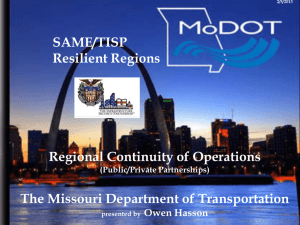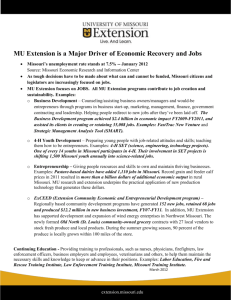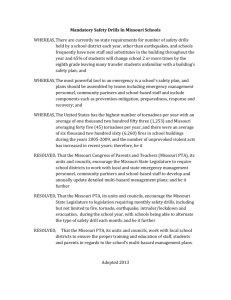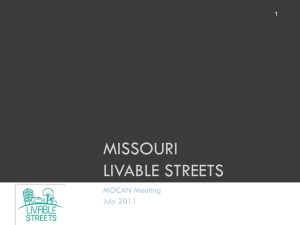School-Wide Crisis Management Presentation
advertisement
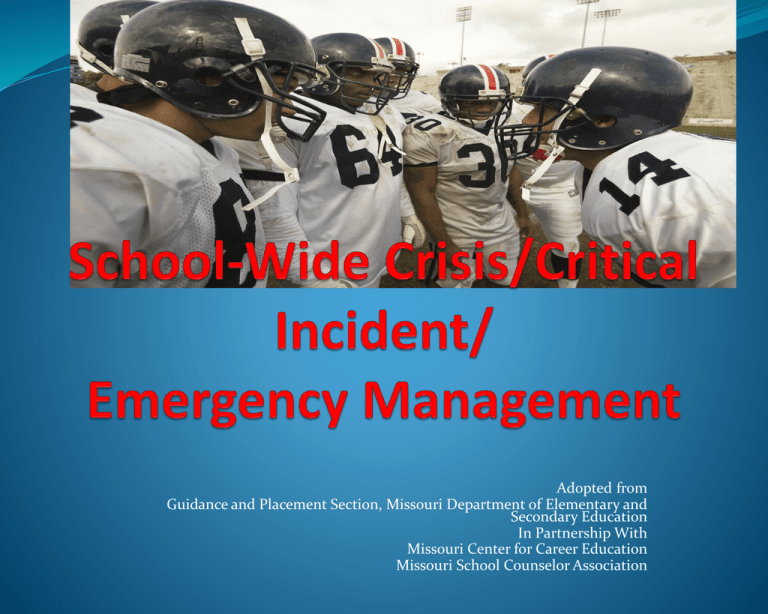
Adopted from Guidance and Placement Section, Missouri Department of Elementary and Secondary Education In Partnership With Missouri Center for Career Education Missouri School Counselor Association It’s a normal Monday, Winter Day; you go to your school for regular work day and at 8:30 a.m. your Principal reports that one of your students was shot and killed over the week end. What do you do? Prepare for final group assignment Define Crisis Intervention Identify Critical Incidents Key Planning Steps What is a crisis? “A crisis is an event that is extraordinary. It cannot be predicted…. [A] crisis is a situation where schools could be faced with inadequate information, not enough time, and insufficient resources, but in which leaders must make one or many crucial decisions.” (USDOE, 2003, p. 1-5). Missouri Comprehensive Guidance Programs: Linking School Success with Life Success 4 A school crisis/critical incident… Effects emotional stability and disrupts the educational process Ranges in scope and intensity Happens anytime anywhere 5 Types of Crises/Critical Incidents Local: Death Suicide Health Issues Accidents Intruders Acts of Violence/Crime (within the local community) Global: Natural Disasters Terrorism Acts of Violence (outside of the local community) Death of a Public Figure 6 Mitigation/Prevention: Services & Programs Preparation/Readiness: Develop Plan for Students, Staff, Parents, Emergency Personnel Response: Plan into Action Recovery: Physical/Emotional Support AND Reflection— What worked? What needs to be changed? Mitigation/Prevention Pre-Planning ● Mitigation/Prevention can diffuse the likelihood of potential acts of violence by students The district’s Comprehensive Guidance Program emphasizes prevention Assess existing school programs & services Know what works and what does not work and make needed modifications 8 Preparation/Readiness Before A Crisis/Critical Incident Planning for the worst-case scenario Training the Plan Exercising the Plan 9 Emergency management plans for all schools Means more effective response Means comprehensive & consistent procedures Practice drills identify areas in the plan that need more attention Developed by representative members of the school/district/community Key “Response Phase” roles/responsibilities are identified & assigned Critical Incident Plan Communication Needs Identified— Internal/External Responsive Services Planning ●Gather/Disseminate the Facts ●Crisis Team Implements Pre-defined Roles and Responsibilities ●Notification of Stakeholders ●Materials/Resources Needed ●Space for Responsive Services ●Debriefing: “Day-Of” Crisis/Critical Incident 12 “The act of providing help to others, may be of significant help to the victim as well as the support provider”… (American School Psychological Association) 1. Support for adults as well as students 2. Evaluation is key to having a strong team and plan 3. Post-crisis/critical incident meeting Review effectiveness of each phase: Make changes as needed 14 What activities can be done with children, after a crisis, to help with their recovery? Coping Strategies Relaxation Exercises Setting Realistic Goals • Write letters to victims • Journaling • Design activity to collect $ • Deep breathing • Muscle relaxation • Pie Metaphor • Develop a solution for each piece of the pie; rather than a total solution all at once Because of the spontaneous nature of crisis, it can upset the balance of an entire school, district and/or community. By committing the time, effort and personnel ahead of time, schools are ready to respond to presented needs in the most appropriate, effective, and comprehensive manner. 17 QUESTIONS/Comments? empower each individual be a hero in his/her own way Adopted from Missouri Comprehensive Guidance Programs: Linking School Success with Life Success 18
